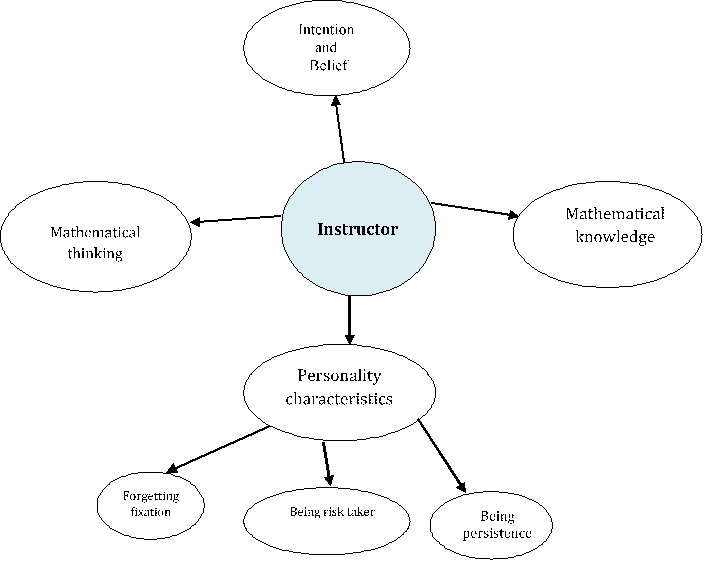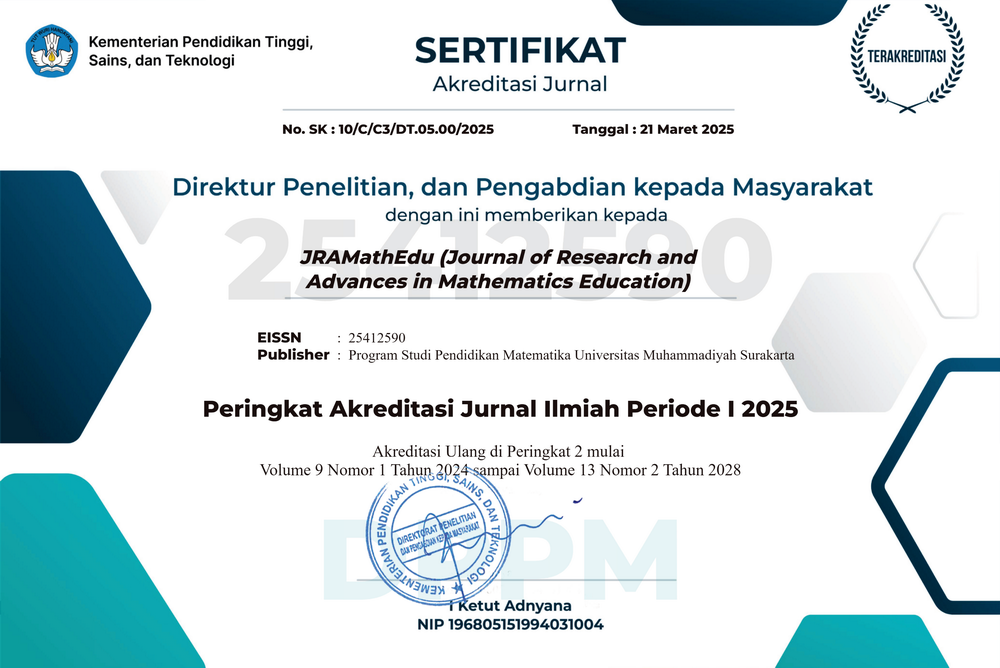A conceptual model of the role of the instructor in fostering students’ mathematical creativity
DOI:
https://doi.org/10.23917/jramathedu.v8i2.3136Keywords:
Mathematics education, Fostering Mathematical creativity, Students of UniversityAbstract
Several studies tried to introduce some of the efficient factors that can influence fostering mathematical creativity in learning environments. since some of the variables associated with mathematical creativity in educational environments depend on the culture, conducting research in this area seems necessary. It should be noted that the contribution of Iranian researchers to these studies is very small. The paper aims to study the role of instructors in nurturing creativity in mathematics students from math students’ point of view and to present a conceptual model. The research is a qualitative study conducted using grounded theory. Participants were selected from university students who are studying mathematics in the universities of the city of Tehran in Iran using purposive sampling and the sampling is stopped until theoretical saturation. Finally, semi-structured in-depth interviews were conducted with 10 students. Interviews were audiotaped, transcribed, and coded in the two stages of free coding and axial coding. Classification of codes led to numerous categories. The findings show that instructors can influence several aspects: belief, intention, mathematical knowledge, mathematical thinking, and personality characteristics such that being persistent, being a risk taker, and forgetting fixation.
References
Anderson, R. C., Katz-Buonincontro, J., Bousselot, T., Mattson, D., Beard, N., Land, J., & Livie, M. (2022). How am I a creative teacher? Beliefs, values, and affect for integrating creativity in the classroom. Teaching and Teacher Education, 110, 103583. https://doi.org/10.1016/j.tate.2021.103583
Andrade, R. R., & Pasia, A. E. (2020). Mathematical creativity of pre-service teachers in solving non-routine problems at State University in Laguna. Universal Journal of Educational Research, 8(10), 4555-4567. https://doi.org/10.13189/ujer.2020.081024
Arikan, E. E. (2017). Is There a Relationship between Creativity and Mathematical Creativity?. Journal of Education and Learning, 6(4), 239-253.
Boden, M. (2004). The creative mind: Myths and mechanisms (2nd ed.). London: Routledge.
Bicer, A. (2021). A systematic literature review: Discipline-specific and general instructional practices fostering the mathematical creativity of students. International Journal of Education in Mathematics, Science, and Technology (IJEMST), 9(2), 252-281. https://doi.org/10.46328/ijemst.1254
Bonyah, E., & Clark, L. J. (2022). Pre-service Teachers’ Perceptions of and Knowledge for Mathematical Modelling in Ghana. Contemporary Mathematics and Science Education, 3(1). https://doi.org/10.30935/conmaths/11932
Brunkalla, K. (2009). How to increase mathematical creativity-An experiment. The Montana Mathematics Enthusiast, 6(1), 257-266.
Burton, L. (1999). The practices of mathematicians: What do they tell us about coming to know mathematics?. Educational Studies in Mathematics, 37(2), 121-143. https://doi.org/10.1023/A:1003697329618
Cai, J., & Leikin, R. (2020). Affect in mathematical problem posing: Conceptualization, advances, and future directions for research. Educational Studies in Mathematics, 105, 287-301. https://doi.org/10.1007/s10649-020-09965-0
Chamberlin, S. A., & Moon, S. M. (2005). Model-eliciting activities as tool to develop and identify creativity gifted mathematicians. Journal of Secondary Gifted Education, 17(1), 37–47. https://doi.org/10.4219/jsge-2005-393
Creswell, J.W. (1998). Qualitative inquiry and research design: Choosing among five raditions. Thousand Oaks, CA: Sage.
Daher, W., & Anabousy, A. (2018). Flexibility of pre-services teachers in problem posing in different environments. In Mathematical creativity and mathematical giftedness (pp. 229-252). Springer, Cham. https://doi.org/10.1007/978-3-319-73156-8_9
Ellwood, S., Pallier, G.,Snyder, A., Gallate,J, (2009). The Incubation Effect: Hatching a Solution? Creativity Research Journal, 21(1), 6–14.
Ervynck, G. (1991). Mathematical creativity. In D. Tall, Advanced mathematical thinking (pp. 42-53). Kluwer Academic Publishers New York. https://doi.org/10.1007/0-306-47203-1_3
Fetterly, J. M. (2020). Fostering mathematical creativity while impacting beliefs and anxiety in mathematics. Journal of Humanistic Mathematics, 10(2), 102-128. https://doi.org/10.5642/jhummath.202002.07
Grégoire, J. (2016). Understanding Creativity in Mathematics for Improving Mathematical Education. Journal of Cognitive Education and Psychology, 15(1), 24-36. https://doi.org/10.1891/1945-8959.15.1.24
Guba, E. G., & Lincoln, Y. S. (1985). Naturalistic inquiry (Vol. 75). Sage Publications, Incorporated.
Hadamard, J. (1945). The Psychology of Invention in the Mathematical Field. Princeton University Press.
Hamid, N. H. A., & Kamarudin, N. (2021). Assessing Students’ Mathematics Achievement and Mathematical Creativity using Mathematical Creative Approach: A Quasi-Experimental Research. Asian Journal of University Education, 17(2), 100-112. https://doi.org/10.24191/ajue.v17i2.13399
Haylock, D.W. (1987). A framework for assessing mathematical creativity in school children. Educational Studies in Mathematics, 18 (1), 59–74. https://doi.org/10.1007/BF00367914
Hersh, R. (1998). Some proposals for revising the philosophy of mathematics. In T. Tymoczko (Ed.), New directions in the philosophy of mathematics (pp. 9-28). Boston: Birkhauser. https://doi.org/10.1016/0001-8708(79)90018-5
Hong, E. & Milgram, R. M. (2008). Preventing Talent Loss. NY.: Routledge.
Jonassen, D. H. (1997). Instructional design models for well-structured and III-structured problem-solving learning outcomes. Educational Technology Research and Development, 45(1), 65-94. https://doi.org/10.1007/BF02299613
Kattou, M., Kontoyianni, K., Pitta-Pantazi, D., Christou, C., & Cleanthous, E. (2012). Predicting Mathematical Creativity. Retrieved from http://mathgifted.org/publications/D3.4.pdf , Google Scholar
Kaufman, J. C., & Sternberg, R. J. (Eds). (2006). The international handbook of creativity. Cambridge: Cambridge University Press.
Kiymaz, Y., Sriraman, B., & Lee, K. H. (2011). prospective secondary mathematics teachers’ mathematical creativity in problem solving: A Turkish study. In The elements of creativity and giftedness in mathematics (pp. 173-191). Brill Sense.
Kontorovich, I., Koichu, B., Leikin, R., & Berman, A. (2011). Indicators of creativity in mathematical problem posing: How indicative are they?. In Proceedings of the 6th international conference on creativity in mathematics education and the education of the gifted students University of Latvia, Riga, Latvia/Angel Kanchev University of Ruse, Ruse, Bulgaria (pp. 120-125).
Kozlowski, J. S., Chamberlin, S. A., & Mann, E. (2019). Factors that influence mathematical creativity. The Mathematics Enthusiast, 16(1), 505-540.
Laycock, M. (1970). Creative mathematics at Nueva, The Arithmetic Teacher, 17, 325-328. https://doi.org/10.5951/AT.17.4.0325
Leikin, R., & Lev, M. (2013). Mathematical creativity in generally gifted and mathematically excelling adolescents: what makes the difference?. ZDM, 45(2), 183-197. https://doi.org/10.1007/s11858-012-0460-8
Leikin, R., Subotnik, R., Pitta-Pantazi, D., Singer, F. M., & Pelczer, I. (2013). Teachers’ views on creativity in mathematics education: An international survey. ZDM, 45(2), 309–324. https://doi.org/10.1007/s11858-012-0472-4
Leung, S. K. S. (1997). On the role of creative thinking in problem posing. ZDM, 29(3), 81-85. https://doi.org/10.1007/s11858-997-0004-9
Lewis, W. M., & Colonnese, M. W. (2021). Fostering mathematical creativity through problem posing and three-act tasks. Gifted Child Today, 44(3), 141-150. https://doi.org/10.1177/10762175211008502
Liljedahl, P., & Sriraman, B. (2006). Musings on mathematical creativity. For The Learning of Mathematics, 26(1), 17-19.
Lincoln, Y.S., & Guba, E.G. (1985). Naturalistic inquiry. Beverly Hills, CA: Sage.
Mann, E. L. (2009). The search for mathematical creativity: Identifying creative potential in middle school students. Creativity Research Journal, 21(4), 338-348. https://doi.org/10.1080/10400410903297402
Mann, E. L. (2005). Mathematical creativity and school mathematics: Indicators of mathematical creativity in middle school students (Doctoral dissertation, University of Connecticut).
Mina, F.(2008). Promoting Creativiy for all students in mathematics educations. Proceedings of the discussing group 9: Promoting Creativity for all students in mathe- maticseducation. In the 11th ICME (Monterrey, Mexico, 2008).
National Council of Teachers of Mathematics. (2000). Principles and Standards for School Mathematics. Reston, VA: Author.
Regier, P., & Savic, M. (2020). How teaching to foster mathematical creativity may impact student self-efficacy for proving. The Journal of Mathematical Behavior, 57, 100720. https://doi.org/10.1016/j.jmathb.2019.100720
Rupnow, R. (2021). Mathematicians’ beliefs, instruction, and students’ beliefs: how related are they?. International Journal of Mathematical Education in Science and Technology, 1-29. https://doi.org/10.1080/0020739X.2021.1998684
Schoenfeld, A. H. (1985). Mathematical problem solving. School of education, Department of mathematics, University of Colifornia, Brekly, Colifornia. Academic Press. INC.
Schoenfeld, A. H. (1992). Learning to think mathematically: Problem solving, metacognition, and sense-making in mathematics. In D. Grouws (Ed.), Handbook for Research on Mathematics Teaching and Learning (pp. 334-370). New York: MacMillan. https://doi.org/10.1177/002205741619600202
Sharma, Y. (2014). The Effects of Strategy and Mathematics Anxiety on Mathematical Creativity of School Students. Mathematics Education, 9(1), 25-37. https://doi.org/10.29333/iejme/279
Shriki, A. (2010). Working like real mathematicians: Developing prospective teachers’ awareness of mathematical creativity through generating new concepts. Educational Studies in Mathematics, 73(2), 159-179. https://doi.org/10.1007/s10649-009-9212-2
Silver, E.A. (1997). Fostering Creativity through Instruction Rich in Mathematical Problem Solving and Problem Posing. ZDM, 29 (3), 75–80. https://doi.org/10.1007/s11858-997-0003-x
Sinitsky, I. (2008). Both for teachers and for Students: on some essential features of creativity- stimulating activities. Proceedings of the 11th International Congress on Mathematical Education Monterrey, Mexico.
Smedsrud, J. H., Nordahl-Hansen, A., & Idsøe, E. (2022). Mathematically gifted students’ experience with their teachers’ mathematical competence and boredom in school: a qualitative interview study. Frontiers in Psychology, 13, 2954. https://doi.org/10.3389/fpsyg.2022.876350
Sriraman, B., & Haavold, P. (2017). Creativity and giftedness in mathematics education: A pragmatic view. First compendium for research in mathematics education. Reston: National Council of Teachers of Mathematics.
Sriraman, B., Haavold, P., & Lee, K. (2013). Mathematical creativity and giftedness: a commentary on and review of theory, new operational views, and ways forward. ZDM, 45(2), 215-225. https://doi.org/10.1007/s11858-013-0494-6
Sriraman, B & Lee, K. (Eds) (2011). The Elements of Creativity and Giftedness in Mathematics. Sense Publishers, Rotterdam.
Sriraman, B. (2009). The characteristics of mathematical creativity. The International Journal on Mathematics Education [ZDM], 41, 13-27. https://doi.org/10.1007/s11858-008-0114-z
Sriraman, B. (2005). Are giftedness & creativity synonyms in mathematics? An analysis of constructs within the professional and school realms. The Journal of Secondary Gifted Education, 17, 20–36. https://doi.org/10.4219/jsge-2005-389
Sternberg, R. J. (1996). Cognitive psychology. USA: Harcourt Brace College Publishers.
Strauss A. & Corbin J. (1998). Basics of Qualitative Research: Techniques and Procedures for Developing Grounded Theory, 2nded. Sage Publications, Thousand Oaks, CA, USA.
Walker, C. (2008). Factors Relating to the Success or Failure of College Algebra Internet Students: A Grounded Theory Study. ProQuest.
Weinhandl, R., & Lavicza, Z. (2021). Real-World Modelling to Increase Mathematical Creativity. Journal of Humanistic Mathematics. https://doi.org/10.5642/jhummath.202101.13
Wessels, H. M. (2014). Levels of mathematical creativity in model-eliciting activities. Journal of Mathematical Modelling and Application, 1(9), 22-40.
Yuan, X., & Sriraman, B. (2011). An exploratory study of relationships between students’ creativity and mathematical problem-posing abilities. In B. Sriraman& K. Lee (Eds).The Elements of Creativity and Giftedness in Mathematics (pp. 5-28). Rotterdam: Sense Publishers.
Zubaidah, S., Fuad, N. M., Mahanal, S., & Suarsini, E. (2017). Improving Creative Thinking Skills of Students through Differentiated Science Inquiry Integrated with Mind Map. Journal of Turkish Science Education TUSED), 14(4), 77-91.

Downloads
Submitted
Published
How to Cite
Issue
Section
License
Copyright (c) 2023 Narges Yaftian

This work is licensed under a Creative Commons Attribution-NonCommercial 4.0 International License.


















